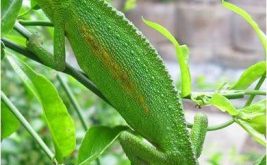Name: Cypriot Scorpion
Scientific name: Mesobuthus Cyprius
Family: Buthidae
Description
This scorpion has a brownish-brown color, which can be considered as red, especially if observed from a distance [1]. It ranges in size from 3 to 19 cm [5], has four pairs of legs, a long tail with six knots, where the latter ends in a curved sting that flows poison. Its two strong calipers are located on the front in arms. It also has two small eyes and another 3-5 smaller ones [6].
Habitat
Scorpions live from tropical to temperate regions, because they can withstand severe drought. They can of course be found in other habitats such as beaches, phrygana, forests, caves and high mountains [4], which is why we find this species in Cyprus. The endemic species of the Cypriot scorpion is generally a fairly common species on the island, which is found in the Troodos areas, as well as on the west and southwest side of the island and specifically in Polis Chrysochous, in the Lemona village of Paphos, in Akrotiri, in Dhekelia and in Kato Pyrgos. In addition, it can be found in some areas in occupied northern Cyprus [2].
In winter the scorpion is not active, as it does not prefer low temperatures. It is considered a nocturnal animal, as during the day it hides in crevices of rocks, under stones or holes in the ground [4,5], while at night it comes out of its hiding place to find food [5]. The habitats of the Cypriot scorpion are barren and semi-arid habitats with little or no vegetation and moderate to limited humidity. They do not dig burrows but choose and use natural areas that look like burrows, under stones and other objects. In the northwestern part of Cyprus it seems that this species can enter gardens and accidentally houses. [2]
Reproduction
Its food is mainly insects, spiders and other small bugs, although some large tropical species also feed on lizards, small mammals and snakes [4,5]. It lays eggs and the female lays 20-30 eggs a few months after mating [5,6]. The search for a mate is the only reason that makes the scorpion leave its hiding place. After mating, the male scorpion becomes food for the female [6]. The mother helps with her tongs to get the little ones out of the eggs, cleans them and places them on her back, where they stay for about 15 days, until their first hatching. During this time the mother stays in her nest continuously, without feeding at all [5,6]. Newborns are white, which have not developed enough, so they do not cause the stinging sensation, nor does their stinging have any harmful effect [1].
Poison
There are about 25 species of scorpions worldwide that have venom capable of causing death in humans [4]. Regarding the Cypriot scorpion, there is no medical data in the literature regarding its venom, but it probably has a sting with moderate venom. There are some cases of patients who have only local effects, with some of the cases involving severe pain [2]. In general, the scorpion-spotted spot should be in immediate contact with hot water, hot sand, or other objects at temperatures above 55 degrees Celsius, until the sensation of pain is gone. A visit to the doctor is of course necessary, especially when the victims are young children, the elderly or people with allergies to scorpion venom [4]. In general, the sting of scorpions living in Europe only causes pain and skin irritation, without being dangerous, unlike scorpions living in the equator, which have a venomous thorn in their tail [5].
Sources:
[1]http://www.pi.ac.cy/pi/files/tekmiriosi/ekdoseis/biblia/arxaia_kypriaki_pezografia.pdf
[2] Gantenbein, B., Kropf, C., Largiader, C. R., & Scholl, A. (2000). Molecular and morphological evidence for the presence of a new buthid taxon (Scorpiones: Buthidae) on the island of Cyprus. Revue suisse de Zoologie,107(1), 213-232.
[3] http://biodiversitycyprus.blogspot.com.cy/2015/08/mesobuthus-cyprius-gantenbein-kropf-2000.html
[4] http://www.patris.gr/articles/2534?PHPSESSID=#.V8PpvE197cs
[5]https://el.wikipedia.org/wiki/%CE%A3%CE%BA%CE%BF%CF%81%CF%80%CE%B9%CF%8C%CF%82_(%CE%B1%CF%81%CE%B8%CF%81%CF%8C%CF%80%CE%BF%CE%B4%CE%BF)
[6] http://www.crete.gr/el/pages/skorpios.php
Photograph sources:
http://biodiversitycyprus.blogspot.com.cy/2015/08/mesobuthus-cyprius-gantenbein-kropf-2000.html
 Κυπριακό Κέντρο Περιβαλλοντικής Έρευνας & Εκπαίδευσης – Κυκπεε
Κυπριακό Κέντρο Περιβαλλοντικής Έρευνας & Εκπαίδευσης – Κυκπεε




